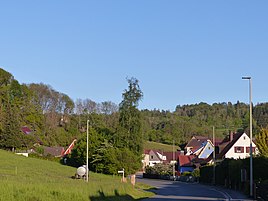Village house
|
Village house
community Weißenohe
Coordinates: 49 ° 37 ′ 31 ″ N , 11 ° 15 ′ 47 ″ E
|
|
|---|---|
| Height : | 382 m above sea level NHN |
| Residents : | 277 (Jan 2019) |
| Postal code : | 91367 |
| Area code : | 09192 |
|
The Weißenoher district of Dorfhaus
|
|
Dorfhaus is a Franconian village located in the north-western part of the Graefenberg flood plain .
geography
The village is one of five districts of the municipality Weißenohe in the south-western part of Upper Franconia . It is located about one kilometer southeast of the center of Weißenohe and is at an altitude of 382 m above sea level. NHN .
history
Towards the end of the Middle Ages, the place, which was then still referred to as a house , was owned by the Weißenohe Monastery, which was part of the Electoral Palatinate . A few years after the end of the Landshut War of Succession , the village came under the jurisdiction of the Hiltpoltstein nursing office in Nuremberg . Because in 1520/21 the Electoral Palatinate and the Imperial City of Nuremberg had contractually agreed to incorporate the monastic properties conquered from the Imperial City during the war into the High Court District of the Nursing Office. However, the so important village and community rulership in Franconia was still exercised by the Weißenohe monastery, which is why Dorfhaus continued to be under Electoral Palatinate sovereignty . When the Electoral Palatinate introduced the Reformation in 1556, according to the definition of Cuius regio, eius religio , the monastic rear-seaters also switched to the Protestant denomination and the subjects living outside of Weißenohe were assigned to the neighboring Protestant parishes. In essence, nothing changed when, after the ostracism of the Palatinate Elector Friedrich V (the so-called Winter King ), the Upper Palatinate was handed over to Kurbaiern as a fief . For Dorfhaus this only meant that the state sovereignty over the place was now taken over by another Wittelsbach line .
Due to the administrative reforms carried out in the Kingdom of Bavaria at the beginning of the 19th century , Dorfhaus became part of the rural community of Weißenohe with the second municipal edict in 1818, which also included the two wastes Mönchsberg and Sonnenberg . In the period that followed, Dorfhaus shared the fate of this community, which was later expanded to include the wasteland Weinberg , which was surrounded by Igensdorf to Weißenohe . In 2019 the village house had 277 residents.
traffic
The connection to the public road network is made by a community road that leads from Weißenohe to Dorfhaus and ends there on the eastern edge of the village as a dead end.
Attractions
Buildings
Up until a few years ago there was a listed farmhouse in the eastern area of Dorfhaus, which was built as a residential stable. However, this building was demolished in 2015.
nature
The village house is traversed by the Lillach , one of the two source brooks of the Aubache . The Lillach rises about two kilometers east of the village in a small spring cave. The spring discharge of this stream can be up to 100 liters / second in certain weather conditions. Below this strong karst spring, the Lillach has formed step-like sintered terraces on an approximately 300-meter-long section, which have been protected as a large natural monument since 1976.
literature
- Ingomar Bog: Forchheim . In: Historical Atlas of Bavaria . Commission for Bavarian State History, Munich 1955.
- Gertrud Diepolder : Bavarian History Atlas . Ed .: Max Spindler . Bayerischer Schulbuch Verlag, Munich 1969, ISBN 3-7627-0723-5 .
- Eckhardt Pfeiffer (Ed.): Nürnberger Land . 3. Edition. Karl Pfeiffer's Buchdruckerei und Verlag, Hersbruck 1993, ISBN 3-9800386-5-3 .
Web links
- Bavarian authorities' guide for village house , accessed on May 15, 2019
- Village house in the BayernAtlas , accessed on May 15, 2019
- Village house (then still referred to as "house") on a historical map , accessed on May 15, 2019
Individual evidence
- ↑ a b Population of the village house , accessed on May 15, 2019
- ^ Village house in the local database of the Bavarian State Library Online . Bavarian State Library, accessed on May 15, 2019.
- ↑ Geographical location of Dorfhaus in the BayernAtlas , accessed on May 15, 2019
- ↑ Gertrud Diepolder : Bavarian History Atlas . Ed .: Max Spindler . Bayerischer Schulbuch Verlag, Munich 1969, ISBN 3-7627-0723-5 , p. 25 .
- ^ Ingomar Bog: Forchheim . S. 18 .
- ^ Eckhardt Pfeiffer (Ed.): Nürnberger Land . 3. Edition. Karl Pfeiffer's Buchdruckerei und Verlag, Hersbruck 1993, ISBN 3-9800386-5-3 , p. 100-101 .
- ^ Ingomar Bog: Forchheim . S. 21 .
- ^ Ingomar Bog: Forchheim . S. 58 .
- ↑ Gertrud Diepolder : Bavarian History Atlas . Ed .: Max Spindler . Bayerischer Schulbuch Verlag, Munich 1969, ISBN 3-7627-0723-5 , p. 98-99 .
- ↑ a b Ingomar Bog: Forchheim . S. 19 .
- ^ Ingomar Bog: Forchheim . S. 125-126 .
- ^ Ingomar Bog: Forchheim . S. 119 .

